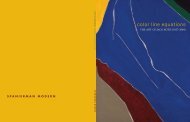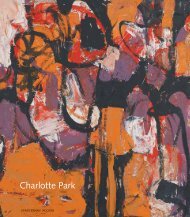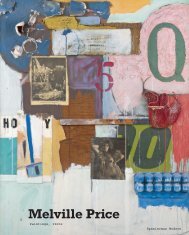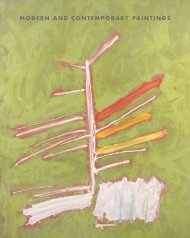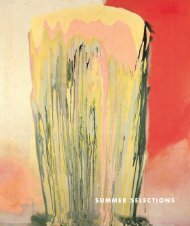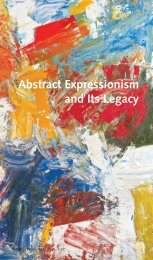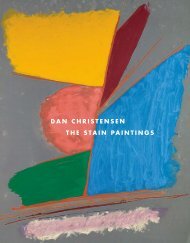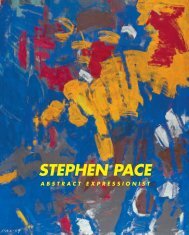BROCHURE (pdf) - Spanierman Modern
BROCHURE (pdf) - Spanierman Modern
BROCHURE (pdf) - Spanierman Modern
Create successful ePaper yourself
Turn your PDF publications into a flip-book with our unique Google optimized e-Paper software.
Stanley Boxer (1926–2000), whose work is in numerousmuseum collections in America and abroad, worked withindefatigable energy during a career that spanned the secondhalf of the twentieth century. Throughout this time, Boxer’spaintings, sculpture, prints (woodblocks and monoprints),and drawings consistently received rave reviews fromthe press. In their extensive coverage, the critics almostinvariably proclaimed each new phase of Boxer’s art to behis best. Whereas many artists’ oeuvres are uneven, Boxersustained a trajectory of novelty and vitality. That he did sostemmed from his working method, in which he kept up anunXagging active and engaged physical involvement in thecreative process.After an early Cubist-Picasso inspired period in the late1940s, Boxer developed an approach that stemmed from theaction painting techniques of Abstract Expressionism andthe optical color sensations and allover approach of ColorField painting. However, he was not ideologically weddedto either aesthetic and combined elements of both at will.Noting his independence, critics have described him as“his own man,” 1 whose “pictures were about seeminglyirreconcilable oppositions,” 2 as an artist “with a grittydisregard for conventional approaches to any medium,” 3as one who “eschewed” schools and retained a uniqueand personal vision, 4 and as a “painter’s painter”; his workwas admired by artists working in many diVerent stylisticmodes. 5 If Boxer’s art can be situated, it would be best tosee it as emanating generally from a painterly traditionstretching back to the old masters. Karen Wilkin has statedthat Boxer culled from “a whole lexicon of time-honoredpainterly qualities—chiaroscuro, sfumata, alla prima texture—into the service of a twentieth-century taste for sparsenessand economy.” 6 While recalling Baroque opulence, Boxer’swork is tempered by modernist restraint and authenticity.In an era when many painters chose to work in acrylic,Boxer was dedicated to a use of oil, which he applied in arich and generous textural impasto. He has often been calleda “sculptor of paint.” Over time, he added collage elements tohis canvases, including such diverse materials as sand, gravel,pebbles, seeds, cork, glitter, roof shingles, and string. Hispassion was for surface vibrancy, in which color, texture, andform work together in a purposeful progression, engagingthe viewer often in an energetic momentum that buildsand develops. The surfaces of his paintings are never still.In their animate qualities, Boxer’s canvases evokeassociations with the natural world without being speciWcallyreferential. As one critic noted, his imagery was basedmore on remembered perceptions of nature than on hisobservations, capturing such qualities as “the feeling of theseasons, recalling the pale heathers and greens of spring,the snowy brightness of winter, the deep purple shadows ofsummer.” 7 Boxer’s images are also often map-like, conveyingsuggestions of landforms, water, and sky, while collagedelements add a topographical and relief dimension to thelater works. In naming his paintings, Boxer’s usual practicewas to string together words. The unbroken titles createa rhythmic complement to his paintings and parallel thecontinuous yet changing cadences of his surfaces as well astheir many associations.Boxer’s paintings reside within a modernist awarenessof the integrity of the surface, but they also demonstratea postmodernist humility. Neither full of existential angstnor stretching for sublime revelation, they express a loveof the sensuous, both in their textural aspects and in theirevocations of the natural world.Among the earliest examples in the show is Still Lifein an Interior (1960). The entirety of this almost-square,densely worked canvas comes alive for the viewer throughits variegated surface, consisting of some areas that arethickly painted with brushy strokes, others in which thepaint is bled into the canvas, and still others in which thebare canvas is exposed. In an upper section of the canvas,the quickened tempo created by rapid strokes loaded witha mix of colors imply elevation change, while vertical



